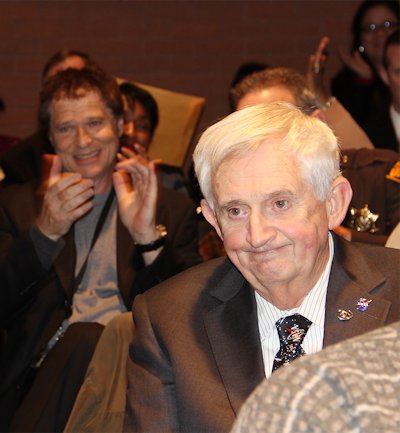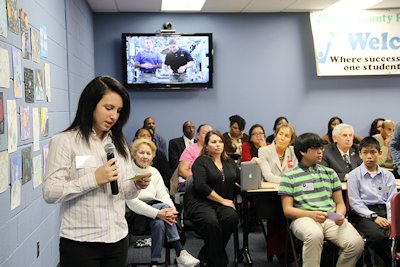
James E. Richmond, a former longtime Charles County Public Schools superintendent, reacts as he learns that the science center at St. Charles High School was named in honor of his efforts to bring STEM education to children in Charles County. (Submitted photo)
Former Superintendent of Schools James E. Richmond says he is overwhelmed that the school system plans to name the science center at St. Charles High School the James E. Richmond Science Center.
Superintendent Kimberly Hill made the naming announcement Nov. 26, calling Richmond the architect of the “wow” factor for students and the visionary behind the center. Hill’s announcement followed an event that allowed Charles County Public Schools (CCPS) students and NASA astronauts to engage during a live 20-minute question/answer session. The event connected 20 students in the Telepresence classroom at La Plata High School to astronauts on the International Space Station.
Hill said the science center has “two amazing, astounding, incredible, monumental features,” including a digital classroom that seats 180 people and Science on a Sphere, a large interactive globe. “Imagine a cross between a planetarium and an IMAX theater,” Hill said as she described the digital classroom, a dome-like structure at the front of the new high school that opens in August 2014. “It’s not just a thing for students, it is something all of our community can benefit from,” Hill said.
“Mr. Richmond always talked about the ‘wow’ factor for students. He is the architect of the ‘wow’ factor for students. The science center at St. Charles High School will be forever known as the James E. Richmond Science Center,” Hill said as she unveiled an architectural rendering with Richmond’s name on the front of the center.
“I am overwhelmed. It is an honor. It is a great center where students, teachers and the community can learn. I think the science center will inspire children and adults for years to come about the wonders of the universe,” Richmond said following the announcement.
Richmond said the idea was to create the “wow” factor for children using state-of-the-art technology that can help “turn on the minds of children and adults as we look to go to other worlds and planets. Technology has implications for all people of the world, and the wonder of space exploration is one way to turn children on to science,” Richmond said.
The science center is located at St. Charles High School and will be open to all students as well as the public. The center is expected to be complete by the summer of 2014.
Students, astronauts talk in real time during NASA downlink

Pictured is Kaylee Wade, Henry E. Lackey High School freshman, who was selected as one of 20 students to asks astronauts Mike Hopkins and Rick Mastroacchio questions about living in outer space during the NASA downlink held Nov. 26 at La Plata High School. (Submitted photo)
Exciting, incredible, magnificent.
That’s how 20 Charles County Public Schools (CCPS) students described talking live to two astronauts on the International Space Station on Nov. 26.
Students began lining up to ask their questions as the words “We are ready. Charles County Public Schools, this is mission control Houston. Please call station for a voice check,” flowed from the Telepresence screen at La Plata High School. Two astronauts appeared on a large screen and the National Aeronautics and Space Administration (NASA) and Charles County Public Schools (CCPS) began Expedition 37/38, a live downlink from space as part of NASA’s Teaching from Space initiative. CCPS is one of seven school systems selected to participate this year.
Twenty CCPS students had the opportunity to question Mike Hopkins and Rick Mastroacchio as the astronauts tossed the microphone back and forth and demonstrated zero gravity by floating around the space station. Students asked the astronauts about life and work in space.
Candace Jackson, a fourth-grade student at William A. Diggs Elementary School, said her favorite part was, “watching the astronauts float around and act silly when they answered my question.” Jackson asked the astronauts, “Why doesn’t the sun make outer space bright?” The fourth grader dreams of becoming a veterinarian or astronaut, and participates on the Mathematics, Engineering and Science Achievement (MESA) team at Diggs.
Students only had 20 minutes with the astronauts, and 18 were able to ask their questions. Questions included: “Have you ever done an experiment on the International Space Station where the results surprised you? How does it feel to walk on Earth when you come back from no gravity? Could you keep a live organism like a fish in space? Do you have to worry about static electricity while in space? In your opinion, would it be hard to live your whole life there if you had a life supply of food and water?”
Time ran out before Gill-Jan Eleazar, a senior at North Point High School, was able to ask his question, but he took the opportunity to end the downlink by wishing the astronauts safe travels. Eleazar wants to join the Marine Corps after high school and possibly train to go to outer space. “When I found out about this opportunity, I started researching on how to become an astronaut,” Eleazar said.
The downlink gave students the ability to interact with astronauts in live time from outer space. “This is the closest a student can get to job shadowing with an astronaut,” said Monique Wilson, director of the James E. Richmond Science Center at St. Charles High School. In-flight education downlinks, according to NASA information, are opportunities for students to interact with crewmembers through a question and answer session. The downlink allows students to hear and see the crewmembers live from space; however, the crewmembers were unable to see the audience.
“Charles County is now part of an elite group,” Wilson said. The downlink is part of NASA’s Teaching from Space Program and a continuation of the CCPS focus on Science, Technology, Engineering and Mathematics (STEM) offerings for students. NASA selected CCPS for the downlink through a competitive proposal process that demonstrates the school system’s commitment to STEM programs and space education. “NASA downlinks happen about 12-15 times a year. With the government furlough this year they are hoping for seven,” Wilson said.
Students participating in the downlink were Branden Hicks, fifth grade, Berry Elementary School; Morgan Thompson, fifth grade, Walter J. Mitchell Elementary School; Candace Jackson, fourth grade, William A. Diggs Elementary School; Nina Brown, second grade, William B. Wade Elementary School; Victoria Gordon, third grade, Indian Head Elementary School; Leah Defalco, fifth grade, Dr. Thomas L. Higdon Elementary School; Jolie Lombardi, second grade, Higdon; Nina Harris, fifth grade, J.C. Parks Elementary School; Tamara McGhee, fifth grade, Mary H. Matula Elementary School; Alisha Douglas, third grade, Eva Turner Elementary School; Elizabeth Parent, eighth grade, Milton M. Somers Middle School; Annie Landgraf, sixth grade, Somers; Misa Oliver, eighth grade, Mattawoman Middle School; Daryl Raguindin, eighth grade, Benjamin Stoddert Middle School; Andrew Fan, seventh grade, Piccowaxen Middle School; Tanina Bivins, junior, La Plata High School; Kris Lukas, sophomore, La Plata; Kaylee Wade, freshman, Henry E. Lackey High School; Adriana Carioti, junior, Thomas Stone High School; and Gill-Jan Eleazar, senior, North Point High School.
A committee of Space Foundation teacher liaisons selected the 20 students based on questions they submitted for the astronauts. Students had an opportunity to submit questions through science and art classes, and teachers submitted their best questions to the committee. The committee included Marissa Cross of Dr. Thomas L. Higdon Elementary School, Lara North of Henry E. Lackey High School, Charles Newcomb of Westlake High School and Aparna Joshi of Milton M. Somers Middle School.
The downlink was broadcast live on NASA TV and streamed live on the NASA website. CCPS taped the program, which can be found at http://beta.ccboe.com/ccboetv/.
School system winter break closures
Charles County Public Schools (CCPS) administrative offices are closed Monday, Dec. 23 through Friday, Dec. 27 for winter break. Offices are also closed Wednesday, Jan. 1, 2014 for New Year’s Day.
CCPS schools are closed Monday, Dec. 23 through Friday, Jan.3, 2014.
Henry E. Lackey and North Point high schools indoor pools are closed Tuesday, Dec. 24, Wednesday, Dec. 25, Tuesday, Dec. 31 and Wednesday Jan. 1, 2014.

